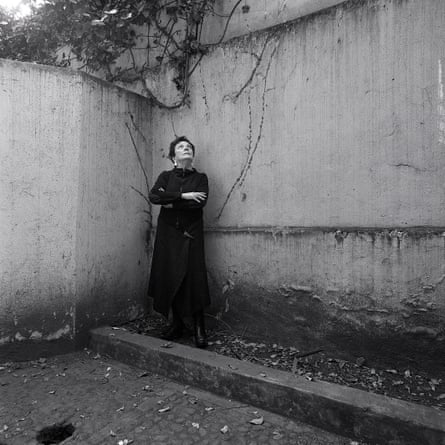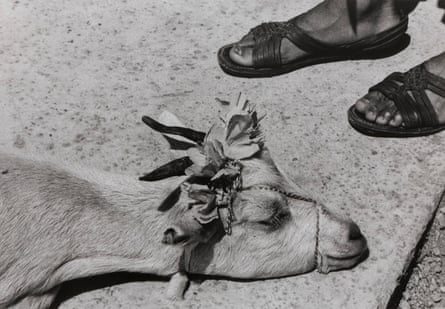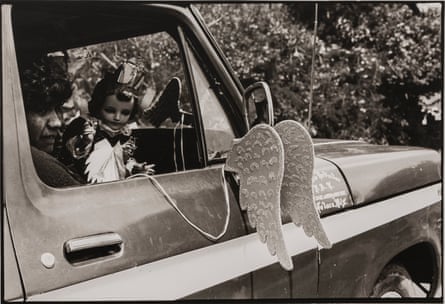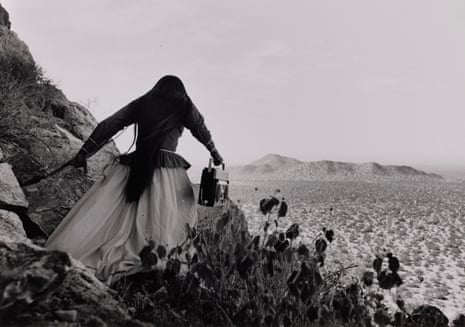Graciela Iturbide was out with her camera in a provincial Mexican town one day in 1978, when she came across a family preparing to bury a baby.
Back in those early years of her career, Iturbide was often drawn to shooting folk rituals around the death of children. It was obvious why: her own daughter had died suddenly at the age of six. But this time was different.
First, the cortege with its near-weightless casket came across a dead man lying in its path, exposed flesh picked away by vultures. Then, in the cemetery, the sky filled with the birds that had been feasting on the corpse.

“I felt as if death had appeared and said, ‘That’s enough! Don’t keep living your suffering in this way. Stop it!’” says Iturbide, on the phone from her home in Mexico City.
The contact sheets from that day provide a frame-by-frame account of how a chance encounter transformed Iturbide’s early compulsion to photograph infant mortality into a longer-lasting fascination with birds. They also illustrate how her work constantly throws up new ways of seeing key themes such as pain, dignity and mystery, and how those themes never go away.
“The camera for me is a pretext for exploring life and culture around the world, and what usually guides me is what surprises me as I look at things,” she says. “If I am not surprised, I cannot take photographs, because it is missing that emotional dimension.”
Graciela Iturbide’s Mexico, a new book that accompanies an exhibition of the same name currently at the Museum of Fine Arts in Boston, explores those surprises in her native country and includes her best-known work from the extended periods she spent in indigenous communities 40-odd years ago.
There is the celebrated image of a regal Zapotec woman with iguanas on her head taken in the southern city of Juchitán, where women famously wield unusual amounts of power, as well as many other photographs featuring faces and bodies that show the strain of hard lives on the margins.

And yet Iturbide, who describes herself as “very politicised” and “of the left”, insists poverty and injustice are never her point. “Whether in my country or in other places, I notice the pain as well as the beauty, but I never shoot poverty,” she insists. “I am interested in taking pictures of people with dignity.”
Iturbide is similarly keen to protect her more recent pictures of Frida Kahlo’s corset, prosthetic leg and other intimate possessions set against the stark background of her bathroom from being sucked up in the mythification of the artist as a feminist icon. “I am not a Fridamaniac,” she says. “What I photographed was Frida’s pain.”
Iturbide draws a quiet satisfaction from the contrast of her images on display in Boston with the anti-Mexican rhetoric coming out of the Trump White House, just as she celebrates the success in Hollywood of the film Roma, directed by her friend Alfonso Cuarón. But she insists there is no political takeaway from her photographs.

“My work is egocentric. It is about what Graciela Iturbide saw when she was taking photographs around the world, nothing more,” she says. “I am showing how I interpret things through all the influences in my life.”
These include her unshakable fascination with what she calls the “paraphernalia of religion” and ritual, which she maintains despite being an atheist. She says its roots in her childhood as the eldest of 13 children in a strict, religious and well-to-do Mexico City family are just too deep, though long since transformed by her creative independence.
The foundations for that freedom lay in her break for liberty at 19 when she married a “relatively liberal man”. Then, after having three children in quick succession, she went to film school and took a class with renowned photographer Manuel Álvarez Bravo.
“Álvarez Bravo taught me another way to live,” she says, downplaying what her mentor taught her about photographic technique.

Now, at the age of 76, Iturbide, who has been described as “one of the most important and influential Latin American photographers of the past four decades, who continues to inspire a younger generation of photographers”, is spending time revisiting old projects, particularly outside Mexico.
These include returning to photograph a group of deaf people within an east LA street gang she first captured on film in her contribution to a 1987 book called A Day in the Life of America. She is currently planning a trip to take pictures of them visiting the grave of a recently deceased female leader.
“I like to maintain a relationship with people I have worked with,” she says. “The experience with them has been very lovely.”
The ever-present importance of time and ritual in Iturbide’s work is also there in her unflinching loyalty to shooting with film. For one thing, she knows that the mysterious surprises she seeks in the field can also lurk on a contact sheet.

That’s what happened with the famed image of a Seri indigenous woman heading down a mountain with the Sonoran desert in northern Mexico stretching out below her.
“It’s my favourite photograph, because I don’t remember taking it,” she says with a laugh. “Maybe it was some kind of spirit out there that took it.”
Graciela Iturbide’s Mexico is published by MFA Publications (£38.32/$49.95)
